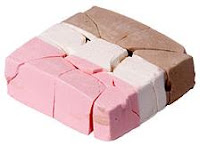 |
| Pouches |
- Maintains original flavor, shape, color, and texture
- It better retains its nutritional value
- The food is condensed, taking up less space
- With all of its water extracted it is extremely light weight
- When water is added, the food completely reconstitutes itself
- Greater peace of mind because of the food’s long shelf life and great taste
 |
| Freeze Dried Ice Cream |
When being freeze dried, a product is first flash frozen (-50 deg C to -80 deg C) and then placed in a vacuum drying chamber for two drying cycles at higher temperatures. This process removes the majority of the water and moistening without affecting taste, color, form or nutritional value.
The Dehydration Process:
 |
| Commercal Dehydrator |
Food Storage: Perhaps insect and rodent invasions first come to mind when considering long-term food storage problems. Although these are formidable opponents when food is not properly secured, the more insidious and damaging culprits are
 time, temperature, moisture, light and oxygen. Exposure to any of these degrades the nutrient quality of the food, greatly decreasing the shelf life during long-term food storage. Products packed in #10 cans, heavy duty plastic buckets and pouches protect food form these elements.
time, temperature, moisture, light and oxygen. Exposure to any of these degrades the nutrient quality of the food, greatly decreasing the shelf life during long-term food storage. Products packed in #10 cans, heavy duty plastic buckets and pouches protect food form these elements.
In the real world, it is often hard to always keep long-term food storage conditions optimal. In addition, many people supplement their survival foods with conventional foods. For these reasons, setting up a rotation system ensures that your precious supplies remain fresh and nutritious. The object is to establish a routine where some stockpiled food is used and replaced on an ongoing basis. This is especially important for food that does not have a long shelf life. Using a wide variety of survival food that can last for several decades limits the amount of time it may take to create and manage a rotation system.

Preparing an organized system of food storage for survival starts with separating the foods based on shelf life. One set of shelves or a rack should be designated for Freeze Dried food storage. These specially prepared survival foods typically last for several decades when kept in reasonable conditions. Another area should be devoted to dried food storage. These dehydrated foods have a longer shelf life than conventional foods, but not as long as Freeze Dried. Conventional, grocery store items get their own set of shelves. Be sure these are the most accessible because this is the area needing the most frequent rotation.
Keep a long-term food storage list by each group of foods. You can use your emergency food storage list to keep track of which foods need to be replenished as you remove items. Keeping the oldest food in the front, while putting the newest acquisitions at the back of the shelves, keeps this system working smoothly. Rotation of survival food may only need to occur every decade or so in your Freeze Dried food storage area. The conventional foods are a different story though, needing much more frequent attention. Rotation of items should be done several times per year at a minimum. Any conventional food item not marked with an expiration date should be marked with a purchase date and used within a year or less.
A long-term food storage chart can be printed out and placed in a storage area. These charts show the average shelf life for a wide range of convention and survival foods. It might seem like a tedious chore keeping a survival food storage list and rotating your supplies, but think of the alternative--food that has gone bad when you desperately need it.
No comments:
Post a Comment